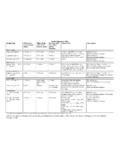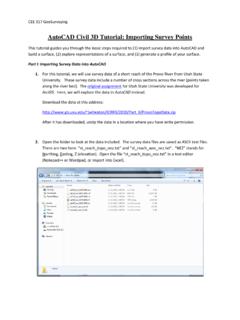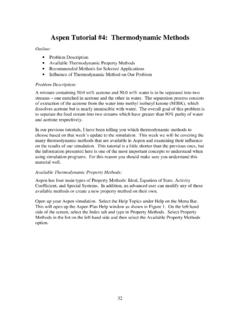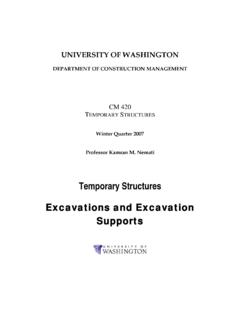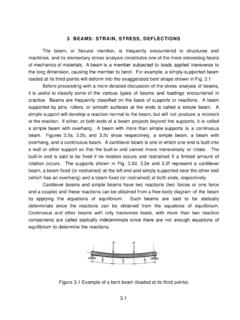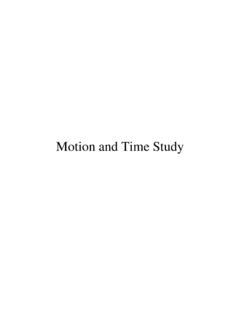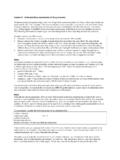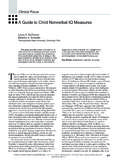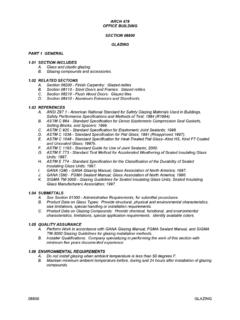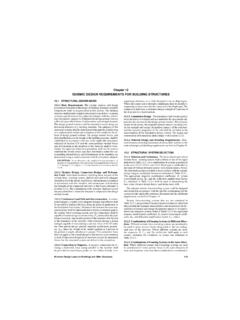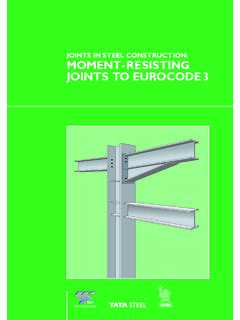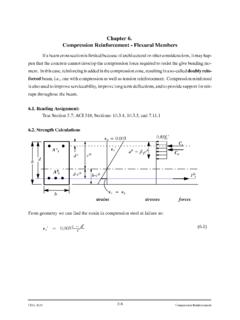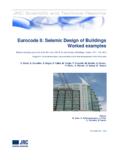Transcription of Curved Beams - courses.washington.edu
1 Curved BeamsDerivation of stress equationsrorihtMMOOMMr-roriycocid abcdb c Neutral AxisCentroidal Axisr-re dANote that y is measured positive inward from the neutral MEMBERS IN FLEXUREThe distribution of stress in a Curved flexural member is determined by using the following The cross section has an axis of symmetry in a plane along the length of the Plane cross sections remain plane after The modulus of elasticity is the same in tension as in will be found that the neutral axis and the centroidal axis of a Curved beam, unlike a straight beam, are not coincident and also that the stress does not vary linearly from the neutral axis. The notation shown in the above figures is defined as follows:ro=radius of outer fiberri=radius of inner fiber h = depth of sectionco=distance from neutral axis to outer fiberci=distance from neutral axis to inner fiber r = radius of neutral axis= radius of centroidalaxise = distance from centroidal axis to neutral axisTo begin, we define the element abcdby the angle.
2 A bending moment M causes section bcto rotate through d to b c . The strain on any fiber at distance from the center 0 isr() drll ==The normal stress corresponding to this strain is(1)() drEE ==Since there are no axial external forces acting on the beam, the sum of the normal forces acting on the section must be zero. Therefore(2)Now arrange Eq. (2) in the form(3)and solve the expression in parentheses. This givesor(4)This important equation is used to find the location of the neutral axis with respect to the center of curvature 0 of the cross section. The equation indicates that the neutral and the centroidal axes are not coincident.()0= = dArdEdA0= dAdArdE 0= AdAr = dAArOur next problem is to determine the stress distribution. We do this by balancing the external applied moment against the internal resisting moment .
3 Thus, from Eq. (2),(5)Since , Eq. (5) can be written in the form(6)Note that r is a constant; then compare the first two terms in parentheses with Eq. (4). These terms vanish, and we have leftThe first integral in this expression is the area A, and the second is the product rA. ThereforeNow, using Eq. (1) once more, and rearranging, we finally obtain()()()MdArdEdAr= = 2()2222 + = rrr + = dAdArdArdArdEM 2() + =dAdArdEM ()eAdEArrdEM = =()yrAeMy = This equation shows that the stress distribution is hyperbolic. The algebraic maximum stresses occur at the inner and outer fibers and are(7)The sign convention used is that M is positive if it acts to straighten on the beam. The distance y is positive inwards to the center of curvature and is measured from the neutral axis. It follows that ciis positive and cois equations are valid for pure bending.
4 In the usual and more general case such as a crane hook, the U frame of a press, or the frame of a clamp, the bending moment is due to forces acting to one side of the cross section under consideration. In this case the bending moment is computed about the centroidal axis, notthe neutral axis. Also, an additional axial tensile (P/A) or compressive (-P/A) stress must be added to the bending stress given by Eq. (7) to obtain the resultant stress acting on the for Some Common SectionsSections most frequently encountered in the stress analysis of Curved Beams are shown For the rectangular section shown in (a), the formulae areFor the trapezoidal section in (b), the formulae are ()ioirrhrandhrr/ln2=+=()[]()ioiooiiooioi irrhrbrbbbArbbbbhrr/ln/23 + =+++=For the T section in we haveThe equations for the solid round sectionof Fig. (d) are ()()[]()[]112112222121/ln/ln22crrbrcrbcb cbrcbcbcbccbcbrriooiiioiioooii++++=++++= ()2224242drrdrdrri =+=

